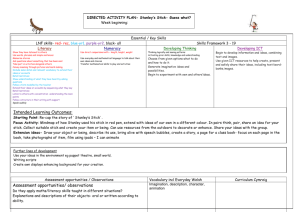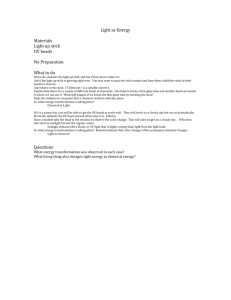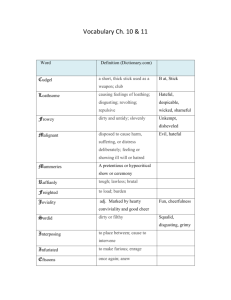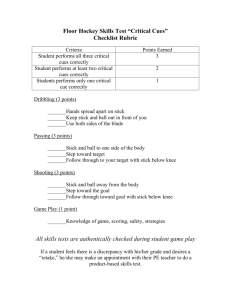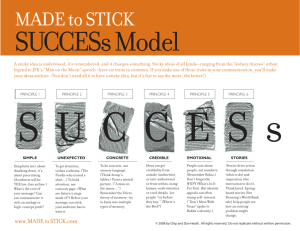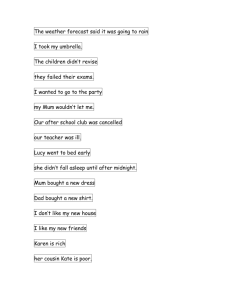Integrating Technology into Mathematics (6-12)
advertisement
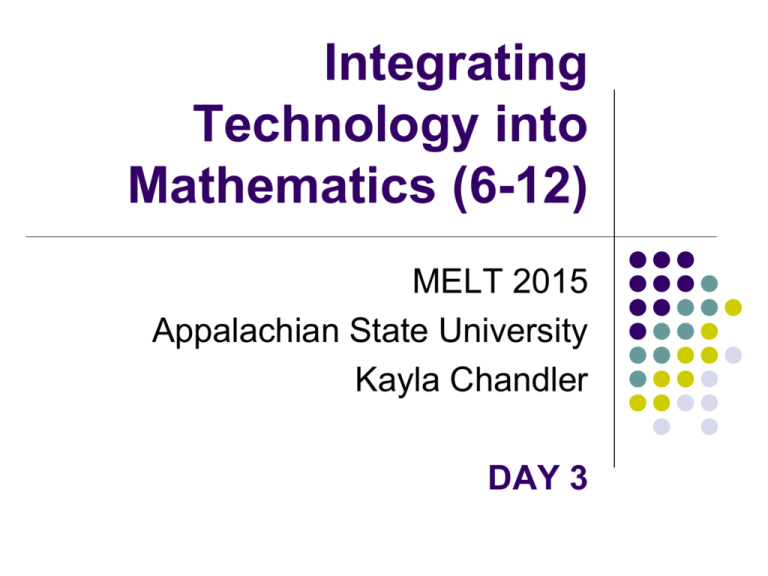
Integrating Technology into Mathematics (6-12) MELT 2015 Appalachian State University Kayla Chandler DAY 3 Agenda Time Activity 8:30 – 10:00 • Exploring Properties using GSP 10:00 – 10:15 Break 10:15 – 11:45 • Transformations 11:45 – 1:00 Lunch 1:00 – 2:30 • Transformations 2:30 – 2:45 Break 2:45 – 4:15 • Lesson Planning Work Session 4:15 – 4:30 Wrap up SESSION 1 Exploring Properties with GSP Open the ExploringProperties.gsp file and identify the properties of the five pentagons. Record the properties in the chart provided and generate a definition for each figure. Questions to Consider Reflect on your thinking processes when generating your definitions. What properties did you consider important or not important? Did you create definitions that did not work? How did you know if a definition “worked” or not? Compare your definitions with the definitions created by others. Consider similarities, differences, strengths, and weaknesses in the different definitions. Questions to Consider Describe the benefits and drawbacks of allowing students to interact with a constructed figure in a DGE to generate their own definitions versus a teacher providing a formal definition to students. When students are generating their own definitions, describe how a teacher can bring these different ideas together so that the class is eventually working from a single definition. Partitional vs. Hierarchical Definitions Partitional definition: considers concepts disjointly from one another; exclusive definition Hierarchical definition: defined as a subset of a more general concept; inclusive definition Questions to Consider Consider the following definitions of a trapezoid: Definition 1: A trapezoid is a quadrilateral with exactly one pair of parallel sides. Definition 2: A trapezoid is a quadrilateral with at least one pair of parallel sides. How would you categorize each definition, partitional or hierarchical? Why? Why might students prefer partitional definitions to hierarchical definitions? When students are generating their own definitions, describe how a teacher can bring these different ideas together so the class is eventually working from a single definition. Questions to Consider Look at your properties for the unknown pentagons. Determine which properties are “inherited” from other properties. Use this information to create a hierarchical classification of these pentagons. Describe how you could apply this same approach you experienced to have students investigate properties of quadrilaterals and generate the accompanying sketch. SESSIONS 2 & 3 Geometric Transformations When you hear this term, what comes to mind? What geometric transformations might you use to describe the dancers? http://www.youtube.com/watch?v=tyZeGOsR9IA http://tumteresources.wikispaces.com/file/view/Da ncing+stick+figure.avi/338311984/Dancing stick figure.avi Translations Create a stick figure in GSP. Translate using polar coordinates 5 cm, 0 degrees Questions to Consider What is true about the size and shape of the two stick figures? Use the Arrow tool to drag a point on the leg of the original stick figure (pre-image). Try dragging a point on the arm of this stick figure. What else changes when you perform this dragging? Why? Questions to Consider Measure the distance between the endpoint of the left leg of the original stick figure and the corresponding point on the left leg of the new stick figure. Measure several other distances for pre-image/image pairs of points. What do you notice? Explain. Questions to Consider Translate your stick figure to create an entire chorus line of dancers that are equidistance apart. Describe how you chose to do this. A student in a high school class asks what the 5 and 0 represent (the values we typed into the polar coordinate dialog box to perform the translation). How do you respond? Translations Open a new sketch and create a new stick figure. Construct a line segment and label it AB. Translate by marked vector. Questions to Consider Translate the second stick figure to have three stick figures on the screen. What do you notice about the size and shape of the three stick figures? How is the location of the stick figures related to the translation vector? Questions to Consider Drag the line segment representing the translation vector so that the tail corresponds with a point on the original stick figure. Where is the head of the vector located? Why? Use the segment tool to create a segment that joins a point from the original stick figure to its corresponding image point. What do you notice about this segment and the vector? Questions to Consider Measure several distances of preimage/image points as you did on your previous sketch. How do these distances relate to one another? How do they relate to the vector AB? What do you think will happen when you translate a line segment? What about a line? What do you think will happen when you translate an angle? Questions to Consider What do you think will happen when you translate two lines that are parallel to each other? You have had the opportunity to perform several different translations. Based on your experiences, describe a translation. Be sure to explain what stays the same and what changes. Questions to Consider Students often have difficulty reasoning about vectors. Because representations of vectors and rays are very similar, students confuse these two objects. Describe how you could assist students in understanding the differences between vectors and rays. Questions to Consider How does this introduction of translations in a dynamic environment, using dancing and stick figures, compare with how you teach translations? What are the benefits and drawbacks of this approach? Reflections Partner dances – moves mirror each other Questions to Consider Explain how you could use the picture above to explain to students that a translation would not be the appropriate transformation to use to describe the positions of the dancers. Reflections In a new sketch create a stick figure and a line or line segment AB. Select AB and choose “Mark Mirror” from the Transform menu. (Or double click AB.) Select entire stick figure and select “Reflect” from the Transform menu. Questions to Consider What do you notice about the size and shape of the two stick figures? Drag a point on the leg of the original stick figure. What happens? Why? Drag other points of the pre-image or image of the stick figure. Predict what will happen if you drag an endpoint of the mirror line segment (point A for example). Drag point A. What happens? Why? Questions to Consider Predict what will happen if you drag point B. Drag point B. What happens? Why? Create a segment joining the hands of the two stick figures as shown below. What do you notice about this segment and the line of reflection? Based on your interactions with the sketch, provide a definition of a reflection. Questions to Consider Describe at least three different properties of reflections. In order for students to develop an appropriate definition of reflection from this activity, it is imperative they focus in on the important properties of reflection. How can a teacher focus students on the relevant properties and assist students in understanding which features of the diagram are not important to consider? Questions to Consider A fixed point for a transformation is when the point is mapped to itself. Did you encounter any fixed points while you were dragging points around in the sketch? Describe fixed points in terms of input and output. Questions to Consider Let’s consider fixed points from an algebraic context. Describe a linear function for which there are infinite fixed points. Describe one or more linear functions for which there are zero fixed points. Describe one or more linear functions that have exactly one fixed point. Questions to Consider Sometimes young students are taught to think about reflections as flips. What properties of reflection are highlighted by thinking about reflections as flips? What properties of reflection are not made as explicit when considering reflections as flips? Rotations Dancers have a vertical axis of rotation (3 dimensions). We will use an aerial view of synchronized swimmers to think about rotations in 2 dimensions. Rotations Open a new sketch and create a stick figure to model one of the swimmers in the picture. Create point C (not on your figure) Mark C as the center of rotation by selecting it and choosing “Mark Center” from the Transform menu (or double clicking it). Select the entire stick figure and choose “Rotate” from the transform menu. Enter 60 degrees and select “Rotate”. Questions to Consider Consider the pre-image and image stick figures. Create a description of the relationship between the two stick figures using a synchronized swimming scenario. What do you notice about the size and shape of the two stick figures? Drag point C and describe what happens to the two stick figures. Explain. Questions to Consider Drag a point on one of the stick figures and describe what happens to the other stick figure. Does it matter which stick figure you drag? Explain. If you constructed a circle with a center at point C that also passes through a point on the original stick figure, what other point will the circle pass through? Use your DGE to test your hypothesis. Questions to Consider Describe at least three different properties of rotations. Are there any fixed points under a rotation? To perform a rotation, most DGEs require that you input a particular angle measure. Describe how this design feature of the technology may influence student thinking about rotations. Questions to Consider Are there particular angles of rotation that would be more or less helpful to use with students? Explain. Mystery Transformations Open the MysteryTransformations.gsp file. Drag the points to determine what transformation was used to create each image point. Translation: describe the translation vector Rotation: identify the center of rotation and the angle of rotation Reflection: locate the line of reflection Questions to Consider Describe your strategies for identifying each of the mystery transformations. Which transformation was the most difficult to determine? Why? SESSION 4 Planning Session This session will be devoted to helping you plan your technology lesson.


